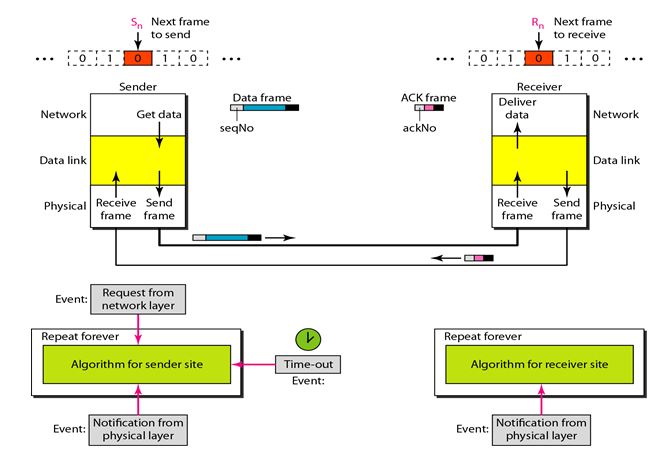Stop and Wait With ARQ Protocol
The Stop-and-Wait Automatic Repeat Request (Stop-and Wait ARQ), adds a simple error control mechanism to the Stop-and-Wait Protocol.
To detect and correct corrupted frames, we need to add redundancy bits to our data frame. When the frame arrives at the receiver site, it is checked and if it is corrupted, it is silently discarded. The detection of errors in this protocol is manifested by the silence of the receiver.
Lost frames are more difficult to handle than corrupted ones. In our previous protocols, there was no way to identify a frame. The received frame could be the correct one, or a duplicate, or a frame out of order. The solution is to number the frames. When the receiver receives a data frame that is out of order, this means that frames were either lost or duplicated.
The corrupted and lost frames need to be resent in this protocol. If the receiver does not respond when there is an error, how can the sender know which frame to resend? To remedy this problem, the sender keeps a copy of the sent frame. At the same time, it starts a timer. If the timer expires and there is no ACK for the sent frame, the frame is resent, the copy is held, and the timer is restarted. Since the protocol uses the stop-and-wait mechanism, there is only one specific frame that needs an ACK even though several copies of the same frame can be in the network.
You May Also Like:
Framing and Framing Protocols
Simplest Protocol
Stop-and- Wait Protocol
Go-Back-N ARQ Protocol
Since an ACK frame can also be corrupted and lost, it too needs redundancy bits and a sequence number. The ACK frame for this protocol has a sequence number field. In this protocol, the sender simply discards a corrupted ACK frame or ignores an out-of-order one.
Sequence Numbers:
In this protocol frames need to be numbered. This is done by using sequence numbers. A field is added to the data frame to hold the sequence number of that frame. One important consideration is the range of the sequence numbers. Since we want to minimize the frame size, we look for the smallest range that provides unambiguous communication.
For example, if we decide that the field is m bits long, the sequence numbers start from 0, go to2m - 1, and then are repeated.
Acknowledgment Numbers:
Since the sequence numbers must be suitable for both data frames and ACK frames, we use this convention: The acknowledgment numbers always announce the sequence number of the next frame expected by the receiver. For example, if frame 0 has arrived safe and sound, the receiver sends an ACK frame with acknowledgment 1 (meaning frame 1 is expected next). If frame 1 has arrived safe and sound, the receiver sends an ACK frame with acknowledgment 0 (meaning frame 0 is expected).
Design
The following figure shows the design of the Stop-and-Wait ARQ Protocol. The sending device keeps a copy of the last frame transmitted until it receives an acknowledgment for that frame. A data frames uses a seqNo (sequence number); an ACK frame uses an ackNo (acknowledgment number). The sender has a control variable, which we call Sn (sender, next frame to send), that holds the sequence number for the next frame to be sent (0 or 1).
The receiver has a control variable, which we call Rn (receiver, next frame expected), that holds the number of the next frame expected. When a frame is sent, the value of Sn is incremented (modulo-2), which means if it is 0, it becomes 1 and vice versa. When a frame is received, the value of Rn is incremented (modulo-2), which means if it is 0, it becomes 1 and vice versa. Three events can happen at the sender site; one event can happen at the receiver site. Variable Sn points to the slot that matches the sequence number of the frame that has been sent, but not acknowledged; Rn points to the slot that matches the sequence number of the expected frame.
Efficiency
The Stop-and-Wait ARQ discussed in the previous section is very inefficient if our channel is thick and long. By thick, we mean that our channel has a large bandwidth; by long, we mean the round-trip delay is long. The product of these two is called the band width delay product.
We can think of the channel as a pipe. The bandwidth-delay product then is the volume of the pipe in bits. The pipe is always there. If we do not use it, we are inefficient. The bandwidth-delay product is a measure of the number of bits we can send out of our system while waiting for news from the receiver.
You May Also Like:
Selective Repeat ARQ Protocol
Piggybacking Protocol
HDLC Configurations,Transfer Modes and Different Types of Frames
Control Fields of HDLC Frames
Back to DCN Questions and Answers


